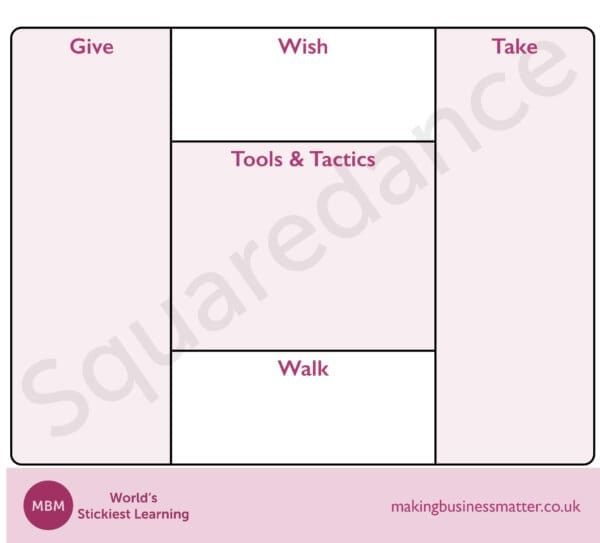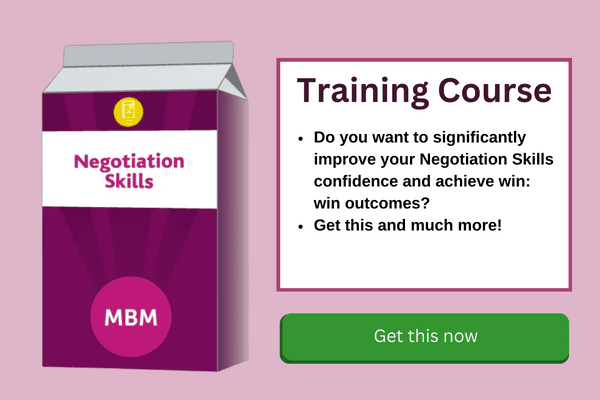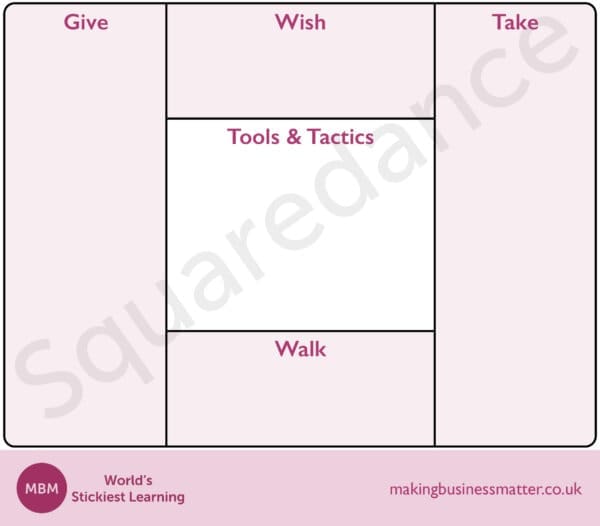‘Squaredance’ to Improve Your Negotiation Preparation
Most people find negotiating tough. It’s tough because it is about conflict. The one thing that would improve your negotiation skills is knowing how to prepare for a negotiation. Yes, negotiation planning. Use this 3-step template to improve your negotiation preparation. We call it ‘The Squaredance’.

Jump Menu:
- There’s a Lack of Tools and Advice for Negotiation Preparation
- The Solution – The Squaredance Negotiation Preparation
- Why Did You Call It That? – Here’s the Story
- Introducing Squaredance Negotiation Preparation Template
- Step #1 – Wish & Walk
- Step #2 – Give & Take
- Step #3 – Tools & Tactics
- Summarising the 3-Step Squaredance Template for Negotiation Planning
Being apprehensive before you negotiate is normal. No one likes conflict. Conflict can lead us to fight or flight. That cave-like response to danger. When we know we need to negotiate – and for some people, that’s a key part of their job – they just want to ‘get stuck in’ (Fight). Others choose to avoid it whenever they can. But this often escalates the negotiation to their boss (Flight).
Consider how often the average National Account Manager (NAM) negotiates – Weekly? Now consider how often they are trained – Twice in their career? Often National Account Managers have a conversation with their Sales Director about an upcoming negotiation. And the conversation is all about their limit of give-away. It is not a structured conversation. It is not about which negotiation tools will work best. And it is a lot about hope.
Now compare this to how often the average supermarket buyer negotiates – Daily? Hourly? And they have trained annually, as a minimum. Without training, you are hugely limiting your chances of success. Plus, without preparing for your negotiations you are limiting your success even further.
There’s a Lack of Tools and Advice for Negotiation Preparation
When I was researching this topic I was stunned by the lack of tools and advice to prepare well for a negotiation. Even Harvard – A publication I usually admire – Wrote an article on a ‘Negotiation Preparation Checklist’. The problem is that they just listed 32 questions to ask yourself. Some of the questions are effective, like, ‘What do I want from this negotiation?’. While others are not, like ‘Does the agenda make room for simultaneous discussion of multiples issues?’. Eh? I am a seasoned negotiator and that blew my mind.
Yes, there are questions to ask. However, they are not 32 in number, nor are they to that extent. Instead, we need a simple yet effective method to prepare your negotiation planning effectively. And here it is…
The Solution – The Squaredance Negotiation Preparation

By using this simple, yet effective 3-step template (The Squaredance) the NAM can prepare in a structured manner that will return these benefits:
Sticky Learning ® is 7 times more effective than 1-day training courses. Plus, you will get a Chain of Evidence proving your Return on Investment. Discover soft skills training that changes behaviours long term.

Benefits of The Squaredance
- Preparation increases confidence because the NAM will have considered their negotiation thoroughly. It’s a little like preparing for a presentation – ‘My audience is…, so I’ll need to be…’
- Also, the structure acts as a checklist of key negotiation elements to consider. Again, like preparing for a presentation – You have written my slides – tick, practised 3 times – tick, big screen talking to the laptop – tick, etc.
- By having a completed template, the NAM and the Sales Director can have a productive discussion about what-ifs. Like preparing for a presentation – you would have emailed the deck to your boss. Currently, the boss just gets a big spreadsheet to look at.
Don’t Use The Squaredance Template If…
You have been negotiating for years. Then there is no need to use this template. Carry on preparing by creating a PowerPoint deck. We both know that it helps, but it is more of a sales tool than a negotiation tool. But what if you could further improve your preparation? Improve your confidence? Win more negotiations? Maybe it’s worth reading on…
Why Did You Call It That? – Here’s the Story
An excellent question. And when we find the answer you’ll be the first to know!
No, seriously.
I was at my best friend’s wedding many years back. He decided that ‘traditional’ was not for them. So in the evening, they had a barn dance instead. Great fun. One of the country dances is a square dance called the ‘Do-Si-Do’. This is Wikipedia’s definition:
‘It is a circular movement where two people, who are initially facing each other, walk around each other without or almost without turning. Dancers advance & pass right shoulders, without turning each dancer moves to the right passing in back of the other dancer. At this moment the partners face away from each other, and then moving backwards dancers pass left shoulders returning to starting position.’
- Two people in a circular motion – Ever had a negotiation that just goes on forever?
- Returning to the same position – Ever argued (negotiated) for a while and arrived back at the start?
- Partners face away from each other – Ever been in a face-to-face or email silence?
You get the idea. We think that negotiating is a lot like dancing and particularly square dancing. An art form, of sorts. Not a science. Two people are locked in a ritual to achieve something, and always one person feels like they had more fun than the other!
Introducing Squaredance Negotiation Preparation Template
We have been training negotiation skills for 18 years. Primarily for manufacturers and retailers in the UK. A tough, tough market where margins are slim. So, our negotiation training course adds huge value.
In the early days, Learners told us that confidence was a problem because they were up against ‘big bad buyers’. Plus, their negotiation preparation was to create a slide deck. Not the best tool for preparing for conflict.
Plus, we knew that confidence often came from preparation. So we put the two together. A means to structure your negotiation preparation that will also give you confidence. We designed this template, and have continually updated it over the last 18 years. It has now become the preparation tool if you want to be an effective negotiator. I introduce <cue country music> ‘The Squredance’…

Complete the form below to get your Free template.
In essence, it is a 3-step template; 1. Wish & Walk, 2. Give & Take, and 3. Tools & Tactics.
Let’s take a look at each of these:
Step #1 – Wish & Walk
If you listen to any advice about negotiating they will tell you to have objectives. That advice is true for almost anything you want to do well. Hence, Stephen Covey’s habit #2 is ‘To begin with the end in mind’. Negotiating is no different. The only difference here is that we are going to add a walk-away point too. Below you can see that step #1 is about the top and bottom sections of the template; ‘Wish’ and ‘Walk’:

-
Wish Section
The Wish section is where you write what you want from your negotiation. Basically, your objectives. Or what you want to achieve. It is a smaller space because you only write your top 3 wishes. For example:
- Case cost of £6.80.
- Two new listings worth +£0.5m.
- To pay no waste costs.
Remember, don’t write all your wishes. Just your key three ones.
Your objectives (wishes) must be smart. You can read about smart objectives. In short, don’t make them woolly. Un-smart examples are; A better case cost, two new listings, and not to get thrashed on waste.
Also, you must be credibly ambitious in your wishes. What do I mean? Imagine you have a 3-year-old Ford Focus to sell. You want £10,000 for it. So what do you advertise it online for? For more. Precisley; £10,950 or £11,995. Everyone who wants to buy a second-hand car will always negotiate for a lower price. So you must pitch your wishes at an ambitiously credible level. The price of £11,995 is credible for a 3-year-old car. Whereas £22,000 will get you no responses because it is not credible!
The 3 items you write in your Wish section are key because they are your guiding star. The thing that you remember above all else. A little like when Usain Bolt steps onto the starting blocks on the track. He’s not thinking, ‘I’ll achieve this in about 10 seconds’. He’s believing, ‘I can run this in 9.45 seconds’. Yours is the same. Set smart targets that you believe in.
-
Walk Section
The Walk section of your Squaredance is where you write your walk-away. Indulge me with a short story…
My wife was bidding on eBay a few months back. She wanted a particular coat. Leather. Brown. Suede. Notably, it was a steal because the asking price was £80. Her walk-away was £145. She bid. Then, someone else entered the fray and bid as well. Then she increased her bid, but so did ‘ebay678’. She did it again. Ebay678 increased its bid. At this point, Ebay678 was becoming very annoying to my wife.
Then, we were into the few remaining hours and the bids continued to increase. In the last few minutes, my wife was at her walk-away price of £145. Ebay678 bid £155. Three minutes to go. £165 went her bid, with a, ‘Don’t say anything. I know what I’m doing’. She got the coat for £170!
The lesson here is, ‘What is your real walk-away?’. It is not the first one you write in the Walk section. The better question is, ‘What are the worst terms you would accept to keep the business?’.
Excuse the Interruption in Improving Your Negotiation Preparation
Our negotiation course will not intimidate you. It will not make you feel silly. It will not be full of old grey men telling stories of how brilliant they are. Most importantly, it will be fun. You will learn a lot. You will become a better negotiator because you will have everything you need to change your behaviours so that you can win more negotiations. That’s a promise! Just complete the form lower down this page, visit our Negotiation Skills Training course, or contact us.

Step #2 – Give & Take
Give & Take are the items that people have heard of, and yet spend little or no time working on them. Sometimes these are called ‘Tradeables‘. The reason they are important is that Tradeables are like the grease of the negotiation engine. They keep everything turning. Without them, the engine seizes up, and you end up in a stalemate or a deadlock. And stalemates are hard to break.
The ‘Gives’ are things that you can give away. ‘Takes’ are things that you want. There are 7 rules when it comes to completing these two sections of the template. If you don’t adhere to these rules your negotiation will stall.
The 7 Rules for Completing the Give and Take Sections for Negotiation Planning:
- For each section, have a minimum of 5. That is, 5 Gives and 5 Takes.
- Have at least as many Gives as you have written Takes. So if you have written 7 Takes, then make sure you have at least the same amount of Gives. This is because it is easy to write Takes. After all, that’s what you want. On the other hand, giving stuff is harder to come up with.
- Have a variety of Gives and Takes. For example, not all the Gives are money, and not all of the Takes are listings.
- Make each Give and Take specific, i.e. not ‘Margin’, but instead ‘An additional category review’.
- Have a range of Gives and Takes. For example, have both low-value Gives and high-value Gives. And do the same for Takes.
- Always trade high value for low cost – I explain this in detail in a moment.
- Advanced – Ideally write a value against each Give and each Take.
The Gives and Takes are used to keep the negotiation moving. For example, ‘If you can get to £7.00 per case, then I can offer in-store sampling for free’. Always give conditionally. Meaning, that you do not give without getting something back.

-
Give Section
The Give section is about writing things that you can give to keep the negotiation moving forward. Examples are:
- Free in-store sampling.
- A category review.
- Offer to support waste.
- Carry out shopper research.
- A better-funded promotion.
- Money for additional point of sales material.
In our negotiation skills training course, one of the sessions is to split the Learners into two groups, to see which team can create the longest list of Gives. This is because often people think that there are very few things to give. The best list ever has been 43 items! Gather your team together for 45 minutes and brainstorm your list. Can you beat 43?
-
Take Section
This section, Take, is easier than Give because it is all the things you want. The surprise is that when we ask Learners to complete this section, they struggle. It is like someone has finally given them the blank chequebook they always wanted, and now they don’t know what to write!
Our challenge to you is to write as many for Takes as you have for the Give section.
Be Smart about Your Gives and Takes
The ideal negotiation on Tradeables is when:
- Your ‘Gives’ cost you little and yet have a high value for them.
- Your ‘Takes’ have a low value for them and a high value for you.
The advanced negotiator plots all the Gives and Takes on a Boston Matrix. The matrix shows all your gives and takes. Plotted by their value to you and your opponent.
For example, above the x-axis (horizontal line) would show a high value to you, and below the x-axis would show a low value to you. To the right of the y-axis (vertical line) would show high value to them and at the left would show low value for them. Therefore an item in the top right would be high value to you both, and an item in the bottom left would be low value to you both.

In negotiation preparation, a completed Boston matrix helps you to identify the ‘sweet ones’. This is the top left box – the Takes that are high value to you, and yet low value to them. As well as the bottom right box – the Gives that are low value to you, and yet high value to them.
Free Download – Negotiation Skills Competency Framework
Step #3 – Tools & Tactics
Preparing what you want (Wish) and don’t want (Walk) is important. Plus what grease (Give & Take) you will use is essential too. The last part tests what you know about the skills of negotiating.
We see many Learners who have attended negotiation skills training but can only recall a couple of things that they might do differently. ‘I remember the silence tool and I have used that’ – that’s hardly worth 3 days of training! They seemed to have been bullied on their training course as a means of showing how tough negotiating can be. It can be tough. But also, some of the best negotiators we have ever had the pleasure to train were marketers. They were the best because they asked questions.
Being tough is not the only way forward and certainly not conducive to learning. Imagine when you were learning to ride your bike and your Dad just kept shouting, ‘When I learned to ride I was much better and you are awful’. There is a better way to be trained.
Build This Section by Adding Groups
Add the groups that are relevant to you. You might add them all. Just add the relevant group/s beneath ‘Tools and Tactics’:

This section is all about the tools, the tricks, the hints, the tips – Whatever you want to call them. This is all about identifying those tools that will work best for you in this negotiation. This does rely on your having a toolbox of tools to pull from.
Soon, we’ll talk about the groups of tools you will need to review. We’ll not share the tools in those groups because there are infinite and that is what we do on training courses. With that said, there will be some useful links to read. For example ‘50 Negotiation Techniques for Account Managers in the UK Grocery Industry‘.
Completing the middle section of Tools and Tactics is about preparing you to use the ‘right’ negotiation tools in your negotiation to achieve your wishes. Another crucial aspect in your negotiation preparation.
Groups of Tools and Tactics That You Need to Consider Adding
Group #1: Question Types
In my experience, everyone has heard of open questions. Yet in practice, they don’t use them. Most questions used illicit a yes or a no response (Closed questions). When you are in stage 2 of negotiating – Exploring – open questions are essential. Unfortunately, unskilled negotiators skip stage 2 and go straight into proposing. This is when they find they are going head to head on price and then stuck in a deadlock.
Be sure to include at least three open questions in this section of the template. This is important because it serves as a reminder not to skip stage 2 of the negotiation process. Moreover, when you find yourself “in the thick of it,” these questions will become your go-to tools—like a get-out-of-jail-free card in Monopoly. Consequently, you won’t be surprised by the valuable information these open questions can reveal.

There are 10 types of questions. Open and closed are just two. Do you know the others? And then can you use them?
Group #2: Influencing and Persuasion Tools
In this group, you add reminders of one or two influencing techniques that you will use. If you cannot name any influencing or persuasion techniques then you will have none available to pull from your toolbox. And you need to get some quick! Our negotiation and influencing skills training course will especially help you in this section of your negotiation preparation.
An example of an influencing technique is the word on head.
Group #3: Tactics
There are many negotiation tactics that you can use. Above you saw a link to 50 of them. Some you’ll have heard of like ‘Using Silence’ and others not, like ‘The Salami’ Tactic. However, the challenge is to consider your opponent, your abilities and what will work best in this negotiation.
For example, if you have used tools before with this person, they will ‘know your game’, and you’ll need to use other tools, but only if you can use them confidently. There is no point in having a ‘socket set’ in your toolbox if you don’t know how to use it.
Make sure that you understand the difference between integrative negotiations and distributive negotiations. In short, integrative is more about working together to get what you both want. Distributive is more working for yourself to get what you want.
Group #4: The Advanced Squaredance – Not for the faint-hearted!
Other Person’s Perspective.
Edward De Bono, a problem-solving expert, came up with 10 tools to help people think. They are very effective and simple. A little like Covey’s habits, but these are tools. They are called, ‘Direct Attention Thinking Tools’ or DATT. One of the tools is ‘O.P.V.’, or ‘Other Person’s View’. The tool encourages you to see it from their point of view. It’s a very powerful tool. We’d encourage you to learn it and then to write a Squaredance as if you were your opponent. Once completed, ask yourself this question, ‘How does your Squaredance need to change based on their Squaredance?’.
Bargaining Arena.
Imagine a ruler placed vertically on the Squaredance. The top of the ruler pokes into the ‘Wish’ section and the bottom end of the ruler pokes into the ‘Walk’ section. Along this ruler, you have placed what you want (Wish) and what you begrudgingly could accept (Walk). This is your bargaining arena. The extent to which you are willing to negotiate.
Now place your opponent’s ruler on the Squaredance. Are they negotiating with the same ruler, but it is upside down compared to yours? In other words, is your and their bargaining arena the same? If yes, then you have a bargaining arena and can negotiate. A successful negotiation is coming out at your walk position, and for you, success is coming away at the wish end of your ruler.
But what if the rulers don’t overlap? This means that there is no bargaining arena. Let me bring to this life with a simple car-buying analogy…
Scenario A: There is a Bargaining Arena:

- Mark is selling his car for £10,000. He wants £11,000. He’d accept £9,000.
- Rachel wants to buy Mark’s car. She’d like to buy it for £9,000. But she’ll go up to £11,000.
- Result: There is a bargaining arena because Mark and Rachel overlap at between £9,000 and £11,000.
Scenario B: There is a No Bargaining Arena:

- Mark is selling his car for £11,000. He wants £11,500. He’d accept £10,500.
- Rachel wants to buy Mark’s car. She’d like to buy it for £9,500. But she’ll go up to £10,000.
- Result: There is no bargaining arena because Mark and Rachel do not overlap. This is because the lowest Mark will accept is £11,000, and the highest Rachel will pay is £10,000. They are £1,000 different. They have little chance of arriving at an agreed price.
By completing a Squaredance for your opponent and considering ‘their ruler’ (Bargaining Arena), you’ll discover how tough the negotiation will be in your negotiation preparation.
Walk, Will, Want and Wish
If you grasped the ruler metaphor of Wish and Walk, then there are two other positions that you can add; Will and Want. In essence, you are preparing for negotiation by having 4 stages of deal prepared; Walk, Will, Want and Wish.
- Walk: This is a deal I’d begrudgingly accept, but not a penny more, otherwise I walk.
- Will: I am willing to do this deal, and have a little ‘left in the bank’.
- Want: This deal I want because it is a good deal.
- Wish: I wish for this deal and I’d love to get it.
Summarising the 3-Step Squaredance Template for Negotiation Planning
Step#1 of the Squaredance Template – Wish & Walk
- Identify your 3 Wishes and your 3 Walks.
Step#2 of the Squaredance Template – Give & Take
- Identify 5 Gives and 5 Takes.
Step#3 of the Squaredance Template – Tools & Tactics
- Add the relevant groups:
-
- Question Types.
- Influencing and Persuasion Tools.
- Tactics.
- For the advanced negotiators: Complete the Squaredance for your opponent and then adjust your Squaredance accordingly. Identify the Bargaining Arena.
All in all, this 3-step template will help you to improve your negotiation preparation. At the start, I promised these 3 advantages:
- Preparation increases confidence because the NAM has considered their negotiation thoroughly.
- The structure acts as a checklist of key elements of the negotiation to consider.
- By having a completed template the NAM and the Sales Director can have a productive discussion about what-ifs.
The Squaredance template has delivered! Best of luck…Cue the country music…




